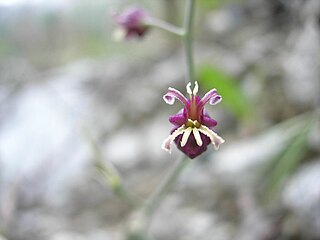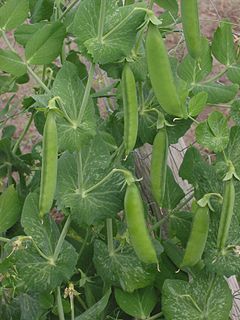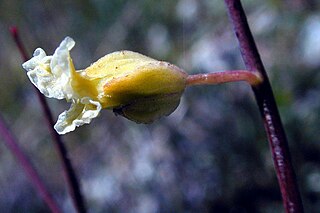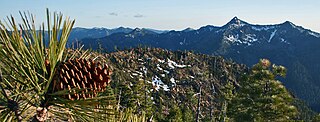
Caulanthus amplexicaulis is a species of flowering plant in the mustard family known by the common name claspingleaf wild cabbage.
Streptanthus hispidus, the Mt. Diablo jewelflower, is a rare species of flowering plant in the mustard family.

Streptanthus albidus is a species of flowering plant in the mustard family known by the common name Metcalf Canyon jewelflower. It is endemic to California, where it is known only from the Central Coast Ranges and San Francisco Bay Area. It grows in open areas such as grasslands, often on serpentine soils.
Streptanthus barbatus is a species of flowering plant in the mustard family known by the common name Pacific jewelflower. It is endemic to the southern Klamath Mountains of far northern California, where it occurs in open wooded habitat among Jeffrey Pines, generally on serpentine soils. It is a perennial herb producing a decumbent or erect, sometimes branching stem up to 70 to 90 centimeters long. It is hairless except for some light hairs on the flowers and the bases of the leaves. The largest leaves are at the base of the plant. They are oval with faintly toothed, bristly edges and borne on short petioles. Leaves above these are oval to rounded and may clasp the stem. Flowers occur at intervals along the upper stem. Each has a spherical to urn-shaped calyx of keeled sepals under a centimeter long with curving petals barely emerging from the tip. The calyx of sepals is whitish, darkening purple in maturity. The petals are purple. The fruit is a long, flat, curving silique which may be 7 centimeters in length.
Streptanthus barbiger is a species of flowering plant in the mustard family known by the common name bearded jewelflower. It is endemic to California, where it is limited to the North Coast Ranges. It grows in woodlands and chaparral habitat, often on serpentine soils. It is an annual herb producing a branching stem up to about 80 centimeters in maximum height. Leaves near the base of the stem are lance-shaped to oval and pointed, usually with toothed edges, the blades measuring up to 7 centimeters long. Leaves higher on the stem may be longer but are narrower and have smooth edges. Flowers occur at intervals along the upper stem. Each has a spherical to urn-shaped calyx of greenish yellow or purple sepals under a centimeter long. Whitish or purple-tinged petals up to a centimeter long emerge from the tip. The fruit is a long, flat, curving silique which may be 7 centimeters in length.
Streptanthus batrachopus is a rare species of flowering plant in the mustard family known by the common name Mt. Tamalpais jewelflower. It is endemic to Marin County, California, where it is known only from Mt. Tamalpais and surrounding terrain. There are fewer than ten known occurrences.
Streptanthus brachiatus is a species of flowering plant in the mustard family known by the common name Socrates Mine jewelflower. It is endemic to the Inner North Coast Ranges of California north of the San Francisco Bay Area. It can be found in chaparral and woodland habitat, often on serpentine soils, in Sonoma, Lake, and Napa Counties. It is a biennial herb producing a branching stem up to about 60 centimeters in maximum height. There is a basal rosette of fleshy purple-green leaves around the base, each with a sharp-toothed, widely lance-shaped blade up to 4 centimeters long. Leaves higher on the stem vary in shape. Flowers occur at intervals along the upper stem. Each has an urn-shaped calyx of keeled yellowish or purplish sepals just under a centimeter long. White, purple, or purple-veined white petals emerge from the tip. The fruit is a thin, narrow silique which may be up to 6 centimeters in length.
Streptanthus breweri is a species of flowering plant in the mustard family known by the common name Brewer's jewelflower. It is endemic to California, where it can be found in the coastal mountain ranges from the Klamath Mountains south to the San Francisco Bay Area. Its habitat includes chaparral and woodlands, usually on serpentine soils. It is an annual herb producing an erect, branching stem up to about 80 centimeters in maximum height. It is hairless except for fine hairs on some of the inflorescence parts, and it may be waxy in texture. The basal leaves have oval blades borne on petioles, and the lance-shaped leaves farther up the stem clasp it at their bases. Flowers occur at intervals along the upper stem, sometimes in a zig-zagging, one-sided array. Each has an urn-shaped calyx of keeled greenish or purplish sepals under a centimeter long. White, purple, or purple-veined white petals emerge from the tip. The fruit is a narrow, curved silique which may be 9 to 11 centimeters in length.
Streptanthus campestris is a species of flowering plant in the mustard family known by the common name southern jewelflower. It is native to southern California and northern Baja California, where it is known from fewer than 20 occurrences scattered between San Bernardino County, California, and Sierra de San Pedro Mártir in northern Baja. It grows in mountain chaparral, woodlands, and forests, at elevations up to 2300 meters. It is a perennial herb producing a thick, few-branched stem up to 1.5 meters tall or more. The basal leaves have fleshy oval blades with bristly, toothed edges which are borne on petioles. Leaves farther up the stem are lance-shaped with smooth or wavy edges and bases that clasp the stem. Flowers occur at intervals on the upper stem. Each has a bell-shaped calyx of bristle-lined purple sepals with four purple tipped yellow petals emerging from the tip. The fruit is a narrow, curving or straight silique which may reach 14 centimeters in length.

Streptanthus diversifolius is a species of flowering plant in the mustard family known by the common name variableleaf jewelflower, or varied-leaved jewelflower. It is endemic to California, where it is limited to the Sierra Nevada foothills. It is a resident of woodlands and other foothill habitat. It is an annual herb producing a hairless, waxy stem up to a meter tall. The basal leaves are variable in shape and are often divided into narrow, threadlike segments. Leaves higher on the stem are also variable, having round to lance-shaped blades which clasp the stem at their bases. Flowers occur at intervals along the upper stem, with one or two leaflike bracts at the base of the raceme. Each flower has an urn-shaped calyx of keeled sepals about half a centimeter long and white, yellowish, or purple in color, sometimes with white edging. White, purple-veined petals emerge from the tip. The fruit is a thin, flat, curving silique which may be 8 or 9 centimeters in length.
Streptanthus drepanoides is an uncommon species of flowering plant in the mustard family known by the common name sicklefruit jewelflower. It is endemic to California, where it is known from a scattered distribution throughout several mountain ranges in the northern part of the state, including the Klamath Mountains. It is a resident of chaparral and woodlands, generally on serpentine soils. It is an annual herb producing a mostly hairless, waxy stem up to 40 or 45 centimeters tall. The ephemeral basal leaves have round or oval blades, sometimes edged with teeth. Leaves higher on the stem have fleshy oval blades that clasp the stem, the lower ones each measuring up to 9 centimeters long by 7.5 wide. Flowers occur at intervals along the upper stem. Each has an urn-shaped calyx of greenish or yellowish sepals under a centimeter long with whitish or purplish, purple-veined petals emerging from the tip. The fruit is a straight or sickle-shaped curving silique up to 9 centimeters long.
Streptanthus farnsworthianus is an uncommon species of flowering plant in the mustard family known by the common name Farnsworth's jewelflower. It is endemic to California, where it is limited to the woodlands of the Sierra Nevada foothills. It is an annual herb producing a hairless, waxy, purple or purple-tinged stem up to half a meter tall or more. The ephemeral basal leaves have blades up to 15 centimeters long which are each divided into several narrow lobes or leaflets. Leaves higher on the stem have purple lance-shaped blades that generally clasp the stem at their bases. Flowers occur at intervals along the upper stem with one or two leaflike purple bracts at the base of the raceme. Each flower has an urn-shaped calyx of purple sepals up to a centimeter long. Curling purple-veined white petals emerge from the tip of the calyx. The fruit is a straight or curving silique up to 12 centimeters long.
Streptanthus fenestratus is an uncommon species of flowering plant in the mustard family known by the common name Tehipite Valley jewelflower.
Streptanthus howellii is an uncommon species of flowering plant in the mustard family known by the common name Howell's jewelflower. It is endemic to the Klamath Mountains of southern Oregon and northern California. It grows in mountain forests on serpentine soils. It is a perennial herb producing a hairless, often waxy-textured stem up to 70 or 80 centimeters in maximum length. It is generally unbranched. The ephemeral basal leaves have fleshy oval blades with smooth or toothed edges, borne on petioles. Leaves farther up the stem are similar but smaller and narrower, with shorter petioles or none. They do not clasp the stem. Flowers occur at intervals along the upper stem. Each has a calyx of purple sepals under a centimeter long with purple-tipped yellow petals emerging from the tip. The fruit is a thin, smooth, curved silique up to 12 centimeters long.
Streptanthus insignis is an uncommon species of flowering plant in the mustard family known by the common names plumed jewelflower and San Benito jewelflower. It is endemic to California, where it is known only from the Inner Central Coast Ranges. It grows in grassland and chaparral habitat, usually on serpentine soils. It is an annual herb producing a hairy, bristly, branching stem up to about 60 centimeters long. The lance-shaped basal leaves are borne on short petioles. Leaves midway up the stem are longer, and those near the top are shorter. They sometimes clasp the stem at their bases. Flowers occur at intervals along the upper stem. The uppermost flowers are often sterile and different in form. Each fertile flower has a bell-shaped calyx of sepals which is purple or greenish-yellow depending on subspecies. The petals at the tip are purplish or yellowish, also depending on subspecies. The fruit is a flat, straight silique which may be over 11 centimeters long.
Streptanthus vernalis is a rare species of flowering plant in the mustard family known by the common name early jewelflower. It was first observed in the 1970s but not actually described to science until 2005. It is endemic to Lake County, California, where it is known from a single occurrence at Three Peaks near the Napa County line. It is apparently limited to serpentine outcrops in forested and chaparral habitat. Genetic analysis indicates that the species is distinct from other Streptanthus and is most closely related to Streptanthus morrisonii, which it resembles. It is a hairless annual herb producing an erect branching or unbranched stem 2 to 20 centimeters tall. The ephemeral basal leaves have thick, fleshy leaves which are green and unmottled on top and purple on the undersides. Leaves higher on the stem are linear to lance-shaped and lack petioles. Flowers occur at intervals along the upper stem. Each flower has an urn-shaped calyx of sepals which is solid green with no purple or yellowish tinge. The petals emerging from the tip are white without darker veining. The fruit is a flattened straight silique 3 to 5 centimeters long containing orange seeds.
Streptanthus morrisonii is an uncommon species of flowering plant in the mustard family known by the common name Morrison's jewelflower. It is endemic to California, where it is known from the North and Central Coast Ranges. It is limited to serpentine soils in chaparral and forest habitat. It is considered a species complex which includes Streptanthus brachiatus. S. morrisonii is divided into four subspecies and is variable. In general, it is a biennial herb producing a hairless, waxy stem up to 1.2 to 1.5 meters in maximum height, often branching at the tip. The basal leaves have fleshy, lance-shaped blades 3 to 5 centimeters long borne on petioles. The blades are gray-green on the upper surface and purple or purple-mottled underneath. Leaves higher on the stem are variable in shape and become smaller toward the top of the plant. Flowers occur at intervals along the upper stem. Each has an urn-shaped calyx of keeled sepals in shades of yellow-green to purple. The petals emerging from the tip are whitish with purple-brown veining. The fruit is a flattened straight or slightly curved silique up to 8 centimeters long.
Streptanthus oliganthus is an uncommon species of flowering plant in the mustard family known by the common name Masonic Mountain jewelflower. It is native to western Nevada and eastern California, where it grows in the rocky hills east of the central Sierra Nevada. Its habitat includes forest, woodland, sagebrush, and mountain talus. It is a rhizomatous perennial herb producing a hairless, waxy, usually unbranched stem up to about 40 or 50 centimeters in maximum height. The basal leaves have lance-shaped, smooth-edged blades up to 10 centimeters long borne on fuzzy to rough-haired petioles. Leaves higher on the stem have shorter blades which may clasp the stem at their bases. Flowers occur at intervals along the upper stem. Each has a bell-shaped calyx of purple sepals no more than a centimeter long. The petals emerging from the tip are reddish purple or purple-tipped. The fruit is a smooth, flat, straight or slightly curved silique up to 8 to 10 centimeters long.
Streptanthus bracteatus is a species of flowering plant in the mustard family known by the common names bracted jewelflower and bracted twistflower. It is endemic to Texas in the United States.















